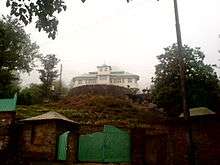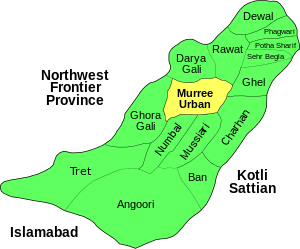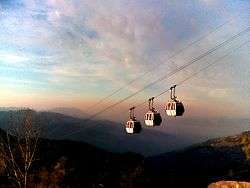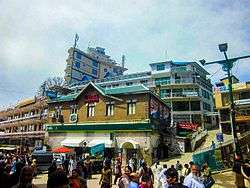Murree
| Murree مری | ||||||||
|---|---|---|---|---|---|---|---|---|
j Right to Left from above to bottom. Patriatta Cable Car, View of Murree, colonial era church, house's in old Murree, view of valley and Mall Road. | ||||||||
| Nickname(s): The Depot (British India), The White City | ||||||||
 Murree Location within Pakistan | ||||||||
| Coordinates: 33°54′15″N 73°23′25″E / 33.9042°N 73.3903°ECoordinates: 33°54′15″N 73°23′25″E / 33.9042°N 73.3903°E | ||||||||
| Country |
| |||||||
| Province | Punjab | |||||||
| District | Rawalpindi | |||||||
| Government | ||||||||
| • Member of the National Assembly | Shahid Khaqan Abbasi | |||||||
| Elevation | 2,291.2 m (7,517.1 ft) | |||||||
| Population | ||||||||
| • Total | 25,247[1] | |||||||
| Time zone | PST (UTC+5) | |||||||
| Number of Union councils | 1 | |||||||
Murree (Punjabi, Urdu: مری, marī, meaning "apex"[2]) is a colonial era town located on the Pir Panjal Range within the Murree Tehsil, Rawalpindi District in Punjab, Pakistan. It forms outskirt of Islamabad Rawalpindi metropolitan area, and is about 30 km (19 mi) northeast of Islamabad City. It has average altitude of 2,291 metres (7,516 ft).[3]
Murree was founded in 1851 as a sanatorium for British troops. The permanent town of Murree was constructed in 1853 and the church was sanctified shortly thereafter. One main road was established, commonly referred to even in modern times, as the mall. Murree was the summer headquarters of the colonial Punjab Government until 1876 when it was moved to Shimla.[4]
Murree became a popular tourist station for British within the British India, several prominent Englishmen were born here including Bruce Bairnsfather, Francis Younghusband and Reginald Dyer.[4] During colonial era acsses to commercial establishments was restricted for non-Europeans including the Lawrence College. In 1901, the population of the town was officially 1,844, although if summer visitors had been included this could have been as high as 10,000.[5]
Since the Independence of Pakistan in 1947, Murree has retained its position as a popular hill station, noted for its pleasant summers. A large number of tourists visit the town from the Islamabad-Rawalpindi area.[6] The town also serves as a transit point for tourist's visiting Azad Kashmir and Abbottabad.[7][8] The town is noted for its Tudorbethan and neo-gothic architecture. The Government of Pakistan own a summer retreat in Murree, where foreign dignitary including heads of state often visit.[9][10]
History
Murree or Marhee as it was then called, was first identified as a potential hill station by Major James Abbott (Indian Army officer) in 1847. [11]
The town's early development was in 1851 by President of the Punjab Administrative Board, Sir Henry Lawrence.[lower-alpha 1] It was originally established as a sanatorium for British troops garrisoned on the Afghan frontier.[12] Officially, the municipality was created in 1850.[13]
The permanent town of Murree was constructed at Sunnybank in 1853. The church was sanctified in May 1857, and the main road, Jinnah Road, originally known as Mall Road and still commonly referred to as "The Mall"), was built. The most significant commercial establishments, the Post Office, general merchants with European goods, tailors and a millinery, were established opposite the church. Until 1947, access to Mall Road was restricted for "natives" (non-Europeans).
In the summer of 1857, a rebellion against the British broke out. The local tribes of Murree and Hazara, including the Dhund Abbasis and others, attacked the depleted British Army garrison in Murree; however, the tribes were ultimately overcome by the British and capitulated.[14] From 1873 to 1875, Murree was the summer headquarters of the Punjab local government;[13] after 1876 the headquarters were moved to Shimla.[12]
The railway connection with Lahore, the capital of the Punjab Province, via Rawalpindi, made Murree a popular resort for Punjab officials, and the villas and other houses erected for the accommodation of English families gave it a European aspect. The houses crowned the summit and sides of an irregular ridge, the neighbouring hills were covered during the summer with encampments of British troops, while the station itself was filled with European visitors from the plains and travellers to Kashmir. It was connected with Rawalpindi by a service of tangas.[13]
It was described in the Gazetteer of Rawalpindi District, 1893–94 as follows:
The sanatorium of Murree lies in north latitude 33° 54′ 30″ and east longitude 73° 26′ 30″, at an elevation of 7,517 feet (2,291 m) above sea level, and contained a standing population of 1,768 inhabitants, which was, however, enormously increased during the [May–November] season by the influx of visitors and their attendant servants and shopkeepers. It is the most accessible hill station in the Punjab, being distant from Rawalpindi only a five hours' journey by tonga dak. Magnificent views are to be obtained in the spring and autumn of the snow crowned mountains of Kashmir; and gorgeous sunset and cloud effects seen daily during the rains [July–August]. Part of the station, especially the Kashmir end, are also well wooded and pretty.
In 1901 the permanent population of the town was 1,844; if summer visitors had been included this could have been as high as 10,000.[12]
Buildings

Islam is the main religion of Murree, however Christian churches from the British era can still be found in Murree and Nathia Gali. There is an Anglican church, built in 1857, located at the centre of the town, which is still used as a place of worship. Many houses around the church are still standing, functioning mostly as hotels. Old traditional restaurants have been replaced by fast-food shops and newer restaurants.
The Murree residence of the Punjab Governor is the Kashmir Point, an imposing building built in the 19th century by the British. There are Punjab and Sindh houses to cater needs of the provincial government. Similarly, there are rest houses for the judges of the Supreme Court and Lahore High Court. A large number of government, semi-government and private departments and institutions maintain guesthouses in Murree. A number of diplomatic missions based in Islamabad established their camp offices in Murree in the 1960s, although they are now seldom used.
Tourism
.jpg)

The Murree Galliat region is known for its scenic vistas of pine- and oak-covered mountains, criss-crossed with springs and rivulets and dotted with lawns and orchards. On clear days a good view of the snowy peaks of Kashmir is possible, and the crest of Nanga Parbat can sometimes be seen. Tourist attractions in the area include the Murree Wildlife Park.Whereas Arjun Bhandari, a senior journalist of Nepal, says the place looks like Nagarkot, a tourist destination of Bhaktapur, Nepal.
Patriata (also called New Murree), is one of the pivotal attractions of Murree. This place, which is 15 km away from Murree Hills, is famous for its chairlift that gives a bird-eye view of the Kashmir green hills. It is at the highest point of Murree Hills that subsequently makes it the highest point of Punjab as well. [15]Ayubia is also a center of attraction in Murree, which comprises four hill stations including Khanspur, Ghor Daka, Changla Gali, Khairagali. Ayubia Chairlift and shops offering cultural shawls, caps and necklaces are the major appeal of this place. Scenic Nathiagali, situated in Abbottabad at a distance of 2500m from Murree, is popular for its maple, pine, walnut and oak trees. Mall road in Murree is the center of major economic activities. The entire road is full of shops selling a multitude of things for the tourists. Major Banks, hotels and restaurants are situated at Mall Road.
Climate and ecology
| Murree | ||||||||||||||||||||||||||||||||||||||||||||||||||||||||||||
|---|---|---|---|---|---|---|---|---|---|---|---|---|---|---|---|---|---|---|---|---|---|---|---|---|---|---|---|---|---|---|---|---|---|---|---|---|---|---|---|---|---|---|---|---|---|---|---|---|---|---|---|---|---|---|---|---|---|---|---|---|
| Climate chart (explanation) | ||||||||||||||||||||||||||||||||||||||||||||||||||||||||||||
| ||||||||||||||||||||||||||||||||||||||||||||||||||||||||||||
| ||||||||||||||||||||||||||||||||||||||||||||||||||||||||||||
Murree features a subtropical highland climate (Cwb) under the Köppen climate classification. It is situated in the outer Himalayas, retaining high altitude. This type of area has cold, snowy winters, relatively cool summer with drastically escalated rain, in relation with lower altitudes, and frequent fog. Precipitation is received year round, with two maxima, first one during winter and second one at summer, July–August. Total mean precipitation annually is 1,789 mm (70.4 in).[16]
A variety of rare animal species can be found in Murree, including the leopard, which inhabits the neighboring Galiyat region. Common animals include the rhesus monkey, wild boar, foxes and various species of birds, including the cheer pheasant and kalij pheasant. Murree gives its name to the Murree vole, a rodent species endemic to Pakistan.
Many fruits introduced to the region during the period of British occupation, including cherries, raspberries and strawberries, still thrive locally.
| Climate data for Muree | |||||||||||||
|---|---|---|---|---|---|---|---|---|---|---|---|---|---|
| Month | Jan | Feb | Mar | Apr | May | Jun | Jul | Aug | Sep | Oct | Nov | Dec | Year |
| Record high °C (°F) | 17.2 (63) |
19.8 (67.6) |
23.0 (73.4) |
26.0 (78.8) |
32.0 (89.6) |
32.2 (90) |
31.7 (89.1) |
27.2 (81) |
25.6 (78.1) |
25.0 (77) |
22.3 (72.1) |
21.1 (70) |
32.2 (90) |
| Average high °C (°F) | 7.2 (45) |
7.5 (45.5) |
11.6 (52.9) |
17.2 (63) |
21.7 (71.1) |
25.1 (77.2) |
22.4 (72.3) |
21.4 (70.5) |
20.9 (69.6) |
18.6 (65.5) |
14.5 (58.1) |
10.2 (50.4) |
16.53 (61.76) |
| Daily mean °C (°F) | 3.7 (38.7) |
4.0 (39.2) |
8.0 (46.4) |
13.2 (55.8) |
17.3 (63.1) |
20.6 (69.1) |
19.1 (66.4) |
18.4 (65.1) |
17.2 (63) |
14.3 (57.7) |
10.3 (50.5) |
6.3 (43.3) |
12.7 (54.86) |
| Average low °C (°F) | 0.1 (32.2) |
0.5 (32.9) |
4.3 (39.7) |
9.1 (48.4) |
12.8 (55) |
16.1 (61) |
15.7 (60.3) |
15.4 (59.7) |
13.4 (56.1) |
10.1 (50.2) |
6.2 (43.2) |
2.4 (36.3) |
8.84 (47.92) |
| Record low °C (°F) | −8.4 (16.9) |
−10.6 (12.9) |
−7 (19) |
−3.3 (26.1) |
0.6 (33.1) |
3.6 (38.5) |
8.9 (48) |
10.0 (50) |
6.0 (42.8) |
1.1 (34) |
−3.3 (26.1) |
−10.5 (13.1) |
−10.6 (12.9) |
| Average precipitation mm (inches) | 126.5 (4.98) |
145.0 (5.709) |
176.8 (6.961) |
133.0 (5.236) |
91.9 (3.618) |
130.3 (5.13) |
339.3 (13.358) |
326.3 (12.846) |
146.5 (5.768) |
70.2 (2.764) |
32.5 (1.28) |
70.3 (2.768) |
1,788.6 (70.418) |
| Source: NOAA (1961-1990) [17] | |||||||||||||
Administration

Murree is one of the largest resort towns in the Galyat region of Pakistan, and is the municipal capital of Murree Tehsil, an administrative division of the Rawalpindi District. As well as being tehsil headquarters, Murree is also a Union Council, bounded to the north by Darya Gali and Rawat, to the west by Ghora Gali and Tret, to the south by Numbal and Mussiari, and to the east by Ghel and Angoori.
Formerly comprising the same administrative unit, in 1850 the British decided to divide the regions between the Rawalpindi and Hazara provinces. However, the two regions are inseparable geographically, culturally, and linguistically.
Localities and Union Councils of the Murree area:
- Rawalpindi District
- Circle Bakote
- Kohati Kakrahi
- Mukeshpuri
- Abbottabad
- Ayubia
- Bhurban
- Birote
- Dewal Sharif
- Darya Gali
- Changla Gali
- Dunga Gali
- Gulehra Gali
- Uc Ghel
- Bochal Kakrahi
- Ghora Gali
- Bansra Gali
- Jhika Gali
- Khaira Gali
- Mohra Sharif
- Nathia Gali
- Aliout, Murree
- Sehr Bagla
- Patriata
- Thandiani
- Karore
- Phagwari
- Las Kothar
- Numbal
- Mussiyari
Military
- "Murree Cantonment" and "Murree Hills Cantonment" redirect here.
For administrative purposes, the military areas of Murree are divided into two separate cantonments, Murree Gali Cantonment and Murree Hills Cantonment. Murree houses the headquarters of the 12th Infantry Division of the Pakistan Army, several educational and training institutions, and a combined military hospital established to cater to the needs of the civilian populations of Murree and adjoining areas. The Pakistan Air Force also maintains a base at Lower Topa, near Patriata, with its own military boarding school for boys, PAF Public School Lower Topa.
During the British Raj, in the hot season Murree was the headquarters of the Lieutenant General of the Northern Command. The Commissioner of the Rawalpindi Division and the Deputy-Commissioner of Rawalpindi also resided here during part of the season, for which period an Assistant Commissioner was placed in charge of the subdivision consisting of Murree Tehsil. The site was selected in 1850 almost immediately after the annexation of the Province, and building operations commenced at once. In 1851 temporary accommodation was provided for a detachment of troops; and in 1853 permanent barracks were erected. The regular garrison generally consisted of two mountain batteries and one battalion of infantry.
Notable inhabitants
Gallery
Sister cities Flint Michigan United States of America 1971
 Conifers
Conifers Himalaya Mountains, Murree, Pakistan.jpg
Himalaya Mountains, Murree, Pakistan.jpg Snowfall in Murree (1865)
Snowfall in Murree (1865) Chair Lifts Murree, Pakistan
Chair Lifts Murree, Pakistan A bridge in Murree (1865)
A bridge in Murree (1865) An old house in Murree (1861)
An old house in Murree (1861)- Convent of Jesus & Mary, famous convent school in Murree
Notes
- ↑ The earliest British discovery of Murree, like many of the adjacent hill resorts in the Galyat range of the Hazara region, was first made by Major James Abbott in 1847. Please see Charles Allen Soldier Sahibs: The Men who made the North West Frontier London: Abacus Books, 2001 p. 141, ISBN 0-349-11456-0; and Journals of Honoria Lawrence eds. J.Lawrence and A. Widdiwis, London: Hodder & Stoughton, 1980 edition. For an account of Abbott's early time in Hazara and founding of Abbottabad, see Omer Tarin and SD Najumddin, "Five Early Military Graves in the Old Christian Cemetery, Abbottabad, Pakistan, 1853-1888", in The Kipling Journal (ISSN 0023-1738) Vol 84, No 339,p.35-52
Citations
- ↑ GeoNames (2007).
- ↑ Concise Dictionary of World Place-Names (2012).
- ↑ "A British town in the hills: Book on Murree launched - The Express Tribune". The Express Tribune. 2013-11-12. Retrieved 2016-10-29.
- 1 2 "Murree Culture | Murree History". www.world66.com. Retrieved 2016-10-29.
- ↑ "About Murree". www.glowpakistan.com. Retrieved 2016-10-29.
- ↑ Correspondent, A (2016-07-10). "Rain, tourists cause traffic jams in Murree". DAWN.COM. Retrieved 2016-10-29.
- ↑ "Independence Day: Festivity plans finalised for Murree - The Express Tribune". The Express Tribune. 2014-08-04. Retrieved 2016-10-29.
- ↑ Asghar, Mohammad (2015-08-14). "Pakistanis not free to go to Murree on Independence Day". DAWN.COM. Retrieved 2016-10-29.
- ↑ "Nawaz, Tajikistan President meet in Murree - Pakistan - Dunya News". dunyanews.tv. Retrieved 2016-10-29.
- ↑ "PM House rejects Imran's Murree 'home renovation' claim". Retrieved 2016-10-29.
- ↑ See note below, re Tarin and Najumddin, op cit, et al
- 1 2 3 Chisholm (1911).
- 1 2 3 Imperial Gazetteer of India (1909).
- ↑ Lee (2001).
- ↑ TDCP. "TDCP (Tourism Development Corporation of Punjab)".
- 1 2 World Weather Information Service (2013).
- ↑ "Murree Climate Normals 1961-1990". National Oceanic and Atmospheric Administration. Retrieved January 16, 2013.
References
- Everett-Heath, John (2012). "Murree". Concise Dictionary of World Place-Names (2nd ed.). Oxford University Press. Retrieved 2012-06-20.
-
 This article incorporates text from a publication now in the public domain: Chisholm, Hugh, ed. (1911). "Murree". Encyclopædia Britannica. 19 (11th ed.). Cambridge University Press. pp. 42–43.
This article incorporates text from a publication now in the public domain: Chisholm, Hugh, ed. (1911). "Murree". Encyclopædia Britannica. 19 (11th ed.). Cambridge University Press. pp. 42–43. - "New Murree project in harmony with environment". Daily Times (Pakistan). 2 August 2005. Retrieved 2012-06-22.
- "Murree, Pakistan". GeoNames. 2007. Retrieved 2013-06-22.
- "Murree Town". Imperial Gazetteer of India. 18. Oxford: Clarendon Press. 1909. p. 42. Retrieved 2013-06-22.
- Lee, Harold (2001). Brothers in the Raj: The Lives of John and Henry Lawrence. Karachi: Oxford University Press. ISBN 0-19-579415-X.
- "World Weather Information Service — Murree". Retrieved 2013-06-22.
- Abbasi, Wajih (26 April 2014). "Political History of Murree". Retrieved 22 June 2014.
External links
| Wikimedia Commons has media related to Murree. |
| Wikivoyage has a travel guide for Murree. |





